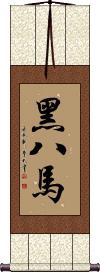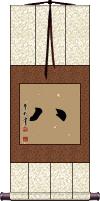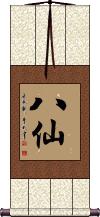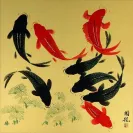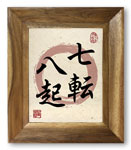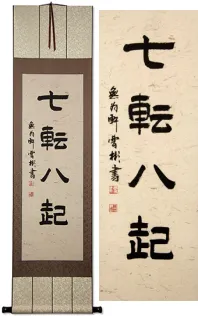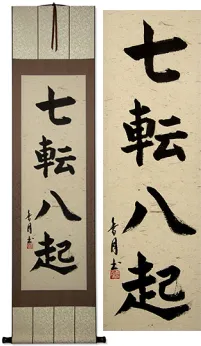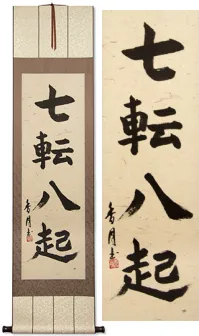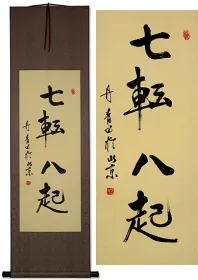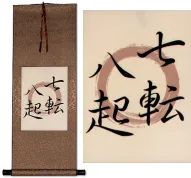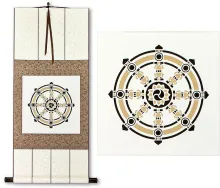Many custom options...
And formats...

The name Eight in Chinese / Japanese...
Buy an Eight calligraphy wall scroll here!
Personalize your custom “Eight” project by clicking the button next to your favorite “Eight” title below...
Eight Black Horses
Eight
The number eight
八 is the number eight in Chinese, Japanese Kanji, and old Korean Hanja.
八 is a strange selection for a wall scroll, so it's here mostly for reference. I guess it's OK if the number eight is important to you.
Because this character is rather simple (just two strokes), 捌 instead of 八 is an anti-fraud way to write eight on bank documents.
Eight Immortals
Fall Down Seven Times, Get Up Eight
Always rising after a fall or repeated failures
七転八起 is a Japanese proverb that relays the vicissitudes of life, with the meaning “seven times down eight times up.”
Some would more naturally translate it into English as “Always rising after a fall or repeated failures” or compare it to the English, “If at first, you don't succeed, try, try again.”
The first Kanji is literally “7.” The second means “fall down” (sometimes this Kanji means “turn around,” “revolve” or “turn over” but in this case, it holds the meaning of “fall”). The third is “8.” And the last is “get up,” “rouse,” or “rise.”
Basically, if you fail 7 times, you should recover from those events and be prepared to rise an 8th time. This also applies if it is the world or circumstances that knock you down seven times...
...just remember that you have the ability to bounce back from any kind of adversity.
Note: This can be pronounced in two ways. One is “shichi ten hakki” or “shichitenhakki.” The other is “nana korobi ya oki” also written, “nanakorobi-yaoki.”
Special Note: The second character is a Kanji that is not used in China. Therefore, please select a Japanese calligrapher for this title.
This in-stock artwork might be what you are looking for, and ships right away...
Gallery Price: $180.00
Your Price: $99.88
Gallery Price: $222.00
Your Price: $122.88
Gallery Price: $222.00
Your Price: $122.88
Gallery Price: $100.00
Your Price: $49.88
Gallery Price: $100.00
Your Price: $39.88
Not the results for eight that you were looking for?
Below are some entries from our dictionary that may match your eight search...
| Characters If shown, 2nd row is Simp. Chinese |
Pronunciation Romanization |
Simple Dictionary Definition |
仙 see styles |
xiān xian1 hsien hisa ひさ |
More info & calligraphy: Immortal(1) (See 仙人・1) hermit; wizard; (2) (See 仙術) wizardry; (personal name) Hisa 僊 ṛṣi, 哩始 an immortal. 仙人; 人仙 the genī, of whom there is a famous group of eight 八仙; an ascetic, a man of the hills, a hermit; the Buddha. The 楞嚴經 gives ten kinds of immortals, walkers on the earth, fliers, wanderers at will, into space, into the deva heavens, transforming themselves into any form, etc. The names of ten ṛṣis, who preceded Śākyamuni, the first being 闍提首那? Jatisena; there is also a list of sixty-eight 大仙 given in the 大孔雀咒經下 A classification of five is 天仙 deva genī, 神仙 spirit genī, 人仙 human genī, 地仙 earth, or cavern genī, and 鬼仙 ghost genī. |
八 see styles |
bā ba1 pa paa / pa パー |
More info & calligraphy: Eight(numeric) eight (chi: bā); (surname) Yatsuyanagi aṣṭa, eight. |
勒 see styles |
lēi lei1 lei roku ろく |
More info & calligraphy: Le(1) bit (horse mouthpiece); (2) (See 永字八法) second stroke in the Eight Principles of Yong; rightward stroke Rein; extort, force; a left stroke; to draw in. |
土 see styles |
tǔ tu3 t`u tu ni に |
More info & calligraphy: Earth(archaism) soil (esp. reddish soil); (place-name) Do Bhū; bhūmi; pṛthivī. Earth, locality, local, vulgar. |
石 see styles |
shí shi2 shih seki せき |
More info & calligraphy: Stone / Rock(counter) (1) counter for jewels in a watch; (counter) (2) counter for transistors, diodes, etc. in an electronic product; (surname) Tsuruishi Stone, rock. |
金 see styles |
jīn jin1 chin kin きん |
More info & calligraphy: Gold / Metal(1) gold (metal); (2) (See 金色) gold (color); (3) gold (medal); first place (prize); (noun - becomes adjective with の) (4) something of great value; something golden (e.g. silence); (5) money; gold coin; (6) (written before an amount of money) sum (of money); (7) (abbreviation) (See 金曜) Friday; (n,ctr) (8) karat (measure of purity of gold); carat; (9) (See 五行・1) metal (fourth phase of Wu Xing); (10) (hist) Jin dynasty (of China; 1115-1234); Chin dynasty; Jurchen dynasty; (11) (abbreviation) {shogi} (See 金将) gold general; (12) (abbreviation) (colloquialism) (See 金玉) testicles; (surname) Kimu; Kim hiraṇya, 伊爛拏 which means cold, any precious metal, semen, etc.; or 蘇伐刺 suvarṇa, which means "of a good or beautiful colour", "golden", "yellow", "gold", "a gold coin", etc. The Chinese means metal, gold, money. |
中道 see styles |
zhōng dào zhong1 dao4 chung tao nakamichi なかみち |
More info & calligraphy: The Middle WayThe 'mean' has various interpretations. In general it denotes the mean between two extremes, and has special reference to the mean between realism and nihilism, or eternal substantial existence and annihilation; this 'mean' is found in a third principle between the two, suggesting the idea of a realm of mind or spirit beyond the terminology of 有 or 無, substance or nothing, or, that which has form, and is therefore measurable and ponderable, and its opposite of total non-existence. See 中論. The following four Schools define the term according to their several scriptures: the 法相 School describes it as the 唯識, v. 唯識中道; the 三論 School as the 八不 eight negations, v. 三論; the Tiantai as 實相 the true reality; and the Huayan as the 法界 dharmadhātu. Four forms of the Mean are given by the 三論玄義. |
八仙 see styles |
bā xiān ba1 xian1 pa hsien hassen はっせん |
More info & calligraphy: Eight Immortals(given name) Hassen |
八卦 see styles |
bā guà ba1 gua4 pa kua hakke; hakka はっけ; はっか |
More info & calligraphy: Ba Gua(1) eight trigrams; divination signs; (2) divination; fortune-telling; (place-name) Hatsuke eight trigrams |
列子 see styles |
liè zǐ lie4 zi3 lieh tzu retsuko れつこ |
More info & calligraphy: Liezi(female given name) Retsuko |
十戒 see styles |
shí jiè shi2 jie4 shih chieh jukkai じゅっかい |
More info & calligraphy: Ten Commandments(1) (Buddhist term) the 10 precepts; (2) Ten Commandments; Decalogue; Decalog; (surname) Jukkai Śikṣāpada. The ten prohibitions (in Pāli form) consist of five commandments for the layman: (1) not to destroy life 不殺生 pāṇātipātāveramaṇi; (2) not to steal 不倫盜 adinnādānāver; (3) not to commit adultery 不婬慾 abrahmacaryaver.; (4) not to lie 不妄語musāvādāver.; (5) not to take intoxicating liquor 不飮酒 suramereyya-majjapamādaṭṭhānāver. Eight special commandments for laymen consist of the preceding five plus: (6) not to eat food out of regulated hours 不非時食 vikāla-bhojanāver.; (7) not to use garlands or perfumes 不著華鬘好香塗身 mālā- gandha-vilepana-dhāraṇa-maṇḍana-vibhūṣanaṭṭhānā; (8) not to sleep on high or broad beds (chastity) 不坐高廣大牀 uccāsayanā-mahāsayanā. The ten commandments for the monk are the preceding eight plus: (9) not to take part in singing, dancing, musical or theatrical performances, not to see or listen to such 不歌舞倡伎不往觀聽 nacca-gīta-vādita-visūkadassanāver.; (10) to refrain from acquiring uncoined or coined gold, or silver, or jewels 不得捉錢金銀寶物 jātarūpa-rajata-paṭīggahaṇāver. Under the Māhayāna these ten commands for the monk were changed, to accord with the new environment of the monk, to the following: not to kill, not to steal, to avoid all unchastity, not to lie, not to slander, not to insult, not to chatter, not to covet, not to give way to anger, to harbour no scepticism. |
四諦 四谛 see styles |
sì dì si4 di4 ssu ti shitai したい |
More info & calligraphy: Four Noble Truths (Buddhism){Buddh} (See 苦集滅道) The Four Noble Truths catvāri-ārya-satyāni; 四聖諦; 四眞諦. The four dogmas, or noble truths, the primary and fundamental doctrines of Śākyamuni, said to approximate to the form of medical diagnosis. They are pain or 'suffering, its cause, its ending, the way thereto; that existence is suffering, that human passion (taṇhā, 欲 desire) is the cause of continued suffering, that by the destruction of human passion existence may be brought to an end; that by a life of holiness the destruction of human passion may be attained'. Childers. The four are 苦, 聚 (or 集), 滅, and 道諦, i. e. duḥkha 豆佉, samudaya 三牟提耶, nirodha 尼棲陀, and mārga 末加. Eitel interprets them (1) 'that 'misery' is a necessary attribute of sentient existence'; (2) that 'the 'accumulation' of misery is caused by the passions'; (3) that 'the 'extinction' of passion is possible; (4) mārga is 'the doctrine of the 'path' that leads to the extinction of passion'. (1) 苦 suffering is the lot of the 六趣 six states of existence; (2) 集 is the aggregation (or exacerbation) of suffering by reason of the passions; (3) 滅 is nirvana, the extinction of desire and its consequences, and the leaving of the sufferings of mortality as void and extinct; (4) 道 is the way of such extinction, i. e. the 八正道 eightfold correct way. The first two are considered to be related to this life, the last two to 出世間 a life outside or apart from the world. The four are described as the fundamental doctrines first preached to his five former ascetic companions. Those who accepted these truths were in the stage of śrāvaka. There is much dispute as to the meaning of 滅 'extinction' as to whether it means extinction of suffering, of passion, or of existence. The Nirvana Sutra 18 says that whoever accepts the four dogmas will put an end to births and deaths 若能見四諦則得斷生死 which does not of necessity mean the termination of existence but that of continued transmigration. v. 滅. |
地獄 地狱 see styles |
dì yù di4 yu4 ti yü jigoku じごく |
More info & calligraphy: Hell(1) {Buddh} hell realm; Naraka; (2) {Christn} Hell; (3) hell; misery; nightmare; inferno; (4) place where a volcano or hot springs constantly spew smoke or steam; (place-name) Jigoku naraka, 捺落迦 (or 那落迦) ; niraya 泥犂; explained by 不樂 joyless; 可厭 disgusting, hateful; 苦具, 苦器 means of suffering; if 地獄 earth-prison; 冥府 the shades, or departments of darkness. Earth-prison is generally intp. as hell or the hells; it may also be termed purgatory; one of the six gati or ways of transmigration. The hells are divided into three classes: I. Central, or radical, 根本地獄 consisting of (1) The eight hot hells. These were the original hells of primitive Buddhism, and are supposed to be located umder the southern continent Jambudvīpa 瞻部州, 500 yojanas below the surface. (a) 等活 or 更活 Saṃjīva, rebirth, where after many kinds of suffering a cold wind blows over the soul and returns it to this life as it was before, hence the name 等活. (b) 黑繩 Kaslasūtra, where the sufferer is bound with black chains and chopped or sawn asunder. (c) 線合; 衆合; 堆壓 Saṃghāta, where are multitudes of implements of torture, or the falling of mountains upon the sufferer. (d) 號呌; 呼呼; 叫喚 Raurava, hell of wailing. (e) 大呌; 大號呌; 大呼 Mahāraurava, hell of great wailing. (f) 炎熱; 燒炙 Tapana, hell of fames and burning. (g) 大熱; 大燒炙; 大炎熱 Pratāpana, hell of molten lead. (h) 無間; 河鼻旨; 阿惟越致; 阿毗至; 阿鼻; 阿毗 Avīci, unintermitted suffering, where sinners die and are reborn to suffer without interval. (2) The eight cold hells 八寒地獄. (a) 頞浮陀地獄 Arbuda, where the cold causes blisters. (b) 尼刺部陀 Nirarbuda, colder still causing the blisters to burst. (c) 頞哳吒; 阿吒吒 Atata, where this is the only possible sound from frozen lips. (d) 臛臛婆; 阿波波 Hahava or Apapa, where it is so cold that only this sound can be uttered. (e) 虎虎婆 Hāhādhara or Huhuva, where only this sound can be uttered. (f) 嗢鉢羅; 鬱鉢羅 (or 優鉢羅) Utpala, or 尼羅鳥 (or 漚) 鉢羅 Nīlotpala, where the skin is frozen like blue lotus buds. (g) 鉢特摩 Padma, where the skin is frozen and bursts open like red lotus buds. (h) 摩訶鉢特摩 Mahāpadma, ditto like great red lotus buds. Somewhat different names are also given. Cf. 倶舍論 8; 智度論 16; 涅槃經 11. II. The secondary hells are called 近邊地獄 adjacent hells or 十六遊增 each of its four sides, opening from each such door are four adjacent hells, in all sixteen; thus with the original eight there are 136. A list of eighteen hells is given in the 十八泥梨經. III. A third class is called the 孤地獄 (獨地獄) Lokāntarika, or isolated hells in mountains, deserts, below the earth and above it. Eitel says in regard to the eight hot hells that they range 'one beneath the other in tiers which begin at a depth of 11,900 yojanas and reach to a depth of 40,000 yojanas'. The cold hells are under 'the two Tchahavālas and range shaft-like one below the other, but so that this shaft is gradually widening to the fourth hell and then narrowing itself again so that the first and last hell have the shortest, those in the centre the longest diameter'. 'Every universe has the same number of hells, ' but 'the northern continent has no hell whatever, the two continents east and west of Meru have only small Lokāntarika hells... whilst all the other hells are required for the inhabitants of the southern continent '. It may be noted that the purpose of these hells is definitely punitive, as well as purgatorial. Yama is the judge and ruler, assisted by eighteen officers and a host of demons, who order or administer the various degrees of torture. 'His sister performs the same duties with regard to female criminals, ' and it may be mentioned that the Chinese have added the 血盆池 Lake of the bloody bath, or 'placenta tank' for women who die in childbirth. Release from the hells is in the power of the monks by tantric means. |
布施 see styles |
bù shī bu4 shi1 pu shih fuse ふせ |
More info & calligraphy: Dana: Almsgiving and Generosity(n,vs,vi) (1) {Buddh} alms-giving; charity; (n,vs,vi) (2) {Buddh} offerings (usu. money) to a priest (for reading sutras, etc.); (surname) Fuho dāna 檀那; the sixth pāramitā, almsgiving, i. e. of goods, or the doctrine, with resultant benefits now and also hereafter in the forms of reincarnation, as neglect or refusal will produce the opposite consequences. The 二種布施 two kinds of dāna are the pure, or unsullied charity, which looks for no reward here but only hereafter; and the sullied almsgiving whose object is personal benefit. The three kinds of dāna are goods, the doctrine, and courage, or fearlessness. The four kinds are pens to write the sutras, ink, the sutras themselves, and preaching. The five kinds are giving to those who have come from a distance, those who are going to a distance, the sick, the hungry, those wise in the doctrine. The seven kinds are giving to visitors, travellers, the sick, their nurses, monasteries, endowments for the sustenance of monks or nuns, and clothing and food according to season. The eight kinds are giving to those who come for aid, giving for fear (of evil), return for kindness received, anticipating gifts in return, continuing the parental example of giving, giving in hope of rebirth in a particular heaven, in hope of an honoured name, for the adornment of the heart and life. 倶舍論 18. |
海德 see styles |
hǎi dé hai3 de2 hai te kaitoku |
More info & calligraphy: HydeThe eight virtues, or powers of the ocean, i.e. vastness, tidal regularity, throwing out of the dead, containing the seven kinds of pearls, absorption of all rivers, of all rain without increase, holding the most mighty fish, universal unvarying saltness. |
八卦掌 see styles |
bā guà zhǎng ba1 gua4 zhang3 pa kua chang hakkeshou / hakkesho はっけしょう |
More info & calligraphy: Ba Gua Zhang{MA} eight trigrams palm; ba gua zhang; pa kua chang |
八極拳 八极拳 see styles |
bā jí quán ba1 ji2 quan2 pa chi ch`üan pa chi chüan hakkyokuken はっきょくけん |
More info & calligraphy: Ba Ji Quanbajiquan (Chinese martial art) |
八正道 see styles |
bā zhèng dào ba1 zheng4 dao4 pa cheng tao hasshōdō はっしょうどう |
More info & calligraphy: The Noble Eightfold Path(Buddhist term) noble eightfold path (八正道分) Āryamārga. The eight right or correct ways, the "eightfold noble path" for the arhat to nirvāṇa; also styled 八道船, 八正門, 八由行, 八游行, 八聖道支, 八道行, 八直行, 八直道. The eight are: (1) 正見Samyag-dṛṣṭi, correct views in regard to the Four Axioms, and freedom from the common delusion. (2) 正思 Samyak-saṁkalpa, correct thought and purpose. (3) 正語 Samyag-vāc, correct speech, avoidance of false and idle talk. (4) 正業 Samyak-karmānta, correct deed, or conduct, getting rid of all improper action so as to dwell in purity. (5) 正命 Smnyag-ājīva, correct livelihood or occupation, avoiding the five immoral occupations. (6) 正精進 Samyag-vyāyāma, correct zeal, or energy in uninterrupted progress in the way of nirvāṇa. (7) 正念 Samyak-smṛti, correct remembrance, or memory, which retains the true and excludes the false. (8) 正定 Samyak-samadhi, correct meditation, absorption, or abstraction. The 正 means of course Buddhist orthodoxy, anything contrary to this being 邪 or heterodox, and wrong. |
不動明王 不动明王 see styles |
bù dòng míng wáng bu4 dong4 ming2 wang2 pu tung ming wang fudoumyouou / fudomyoo ふどうみょうおう |
More info & calligraphy: Fudo Myo-o / Wisdom King不動尊 Aryacalanatha 阿奢羅曩 tr. 不動尊 and 無動尊 and Acalaceta, 阿奢囉逝吒 tr. 不動使者. The mouthpiece or messenger, e. g. the Mercury, of the Buddhas; and the chief of the five Ming Wang. He is regarded as the third person in the Vairocana trinity. He has a fierce mien overawing all evil spirits. He is said to have attained to Buddhahood, but also still to retain his position with Vairocana. He has many descriptive titles, e. g. 無量力神通無動者; 不動忿怒王, etc. Five different verbal signs are given to him. He carries a sharp wisdom-sword, a noose, a thunder-bolt. The colour of his images is various—black, blue, purple. He has a youthful appearance; his hair falls over his left shoulder; he stands or sits on a rock; left eye closed; mouth shut, teeth gripping upper lip, wrinkled forehead, seven locks of hair, full-bodied, A second representation is with four faces and four arms, angry mien, protruding teeth, with fames around him. A third with necklaces. A fourth, red, seated on a rock, fames, trident, etc. There are other forms. He has fourteen distinguishing symbols, and many dharanis associated with the realm of fire, of saving those in distress, and of wisdom. He has two messengers 二童子 Kimkara 矜羯羅 and Cetaka 制吒迦, and, including these, a group of eight messengers 八大童子 each with image, symbol, word-sign, etc. Cf. 不動佛. |
愛別離苦 爱别离苦 see styles |
ài bié lí kǔ ai4 bie2 li2 ku3 ai pieh li k`u ai pieh li ku aibetsuriku あいべつりく |
More info & calligraphy: The Pain of Separation from Your Loves(yoji) {Buddh} the pain of separation from loved ones The suffering of being separated from those whom one loves. v. 八苦. |
側 侧 see styles |
zhāi zhai1 chai soku そく |
lean on one side (See 永字八法) first principle of the Eight Principles of Yong; tiny dash or speck; (surname) Soba lean to one side |
兌 兑 see styles |
duì dui4 tui da だ |
to cash; to exchange; to add (liquid); to blend; one of the Eight Trigrams 八卦[ba1 gua4], symbolizing swamp; ☱ dui (one of the trigrams of the I Ching: swamp, west); (given name) Tooru |
化 see styles |
huà hua4 hua ka か |
to make into; to change into; -ization; to ... -ize; to transform; abbr. for 化學|化学[hua4 xue2] (suffix) (after a noun) (See 機械化,映画化) change to ...; becoming ...; making into ...; -ization; -ification; (personal name) Fua To transform, metamorphose: (1) conversion by instruction, salvation into Buddhism; (2) magic powers 通力 of transformation, of which there are said to be fourteen mental and eight formal kinds. It also has the meaning of immediate appearance out of the void, or creation 無而忽起; and of giving alms, spending, digesting, melting, etc. |
卦 see styles |
guà gua4 kua ke け |
divinatory diagram; one of the eight divinatory trigrams of the Book of Changes 易經|易经[Yi4 jing1]; one of the sixty-four divinatory hexagrams of the Book of Changes 易經|易经[Yi4 jing1] divination sign |
啄 see styles |
zhuó zhuo2 cho taku たく |
to peck (See 永字八法) seventh principle of the Eight Principles of Yong; stroke that falls leftwards with slight curve; (given name) Taku |
因 see styles |
yīn yin1 yin in いん |
cause; reason; because (1) cause; factor; (2) {Buddh} (See 縁・えん・5) hetu (direct cause, esp. as opposed to indirect conditions); (3) (See 因明) the basis of one's argument (in hetuvidya); (personal name) Yukari hetu: a cause: because: a reason: to follow, it follows, that which produces a 果 result or effect. 因 is a primary cause in comparison with 緣 pratyaya which is an environmental or secondary cause. In the 十因十果 ten causes and ten effects, adultery results in the iron bed, the copper pillar, and the eight hot hells; covetousness in the cold hells; and so on, as shown in the 楞嚴經. Translit. in, yin. Cf. 印. |
坎 see styles |
kǎn kan3 k`an kan kan かん |
pit; threshold; one of the Eight Trigrams 八卦[ba1 gua4], symbolizing water; ☵ (1) (archaism) pit; hole; (2) kan (one of the trigrams of the I Ching: water, north); (surname) Kita |
坤 see styles |
kūn kun1 k`un kun kon こん |
one of the Eight Trigrams 八卦[ba1 gua4], symbolizing earth; female principle; ☷; ancient Chinese compass point: 225° (southwest) kun (one of the trigrams of the I Ching: earth, southwest); (given name) Mamoru earth |
巽 see styles |
xùn xun4 hsün son そん |
to obey; one of the Eight Trigrams 八卦[ba1 gua4], symbolizing wood and wind; ☴; ancient Chinese compass point: 135° (southeast) xun (one of the trigrams of the I Ching: wind, southeast); (given name) Yuzuru |
戒 see styles |
jiè jie4 chieh kai; ingoto(ok) かい; いんごと(ok) |
to guard against; to exhort; to admonish or warn; to give up or stop doing something; Buddhist monastic discipline; ring (for a finger) (1) (かい only) {Buddh} admonition; commandment; (2) sila (precept) śīla, 尸羅. Precept, command, prohibition, discipline, rule; morality. It is applied to the five, eight, ten, 250, and other commandments. The five are: (1) not to kill; (2 ) not to steal; (3) not to commit adultery; (4) not to speak falsely; (5) not to drink wine. These are the commands for lay disciples; those who observe them will be reborn in the human realm. The Sarvāstivādins did not sanction the observance of a limited selection from them as did the 成實宗 Satyasiddhi school. Each of the five precepts has five guardian spirits, in all twenty-five, 五戒二十五神. The eight for lay disciples are the above five together with Nos. 7, 8, and 9 of the following; the ten commands for the ordained, monks and nuns, are the above five with the following: (6) not to use adornments of flowers, nor perfumes; (7) not to perform as an actor, juggler, acrobat, or go to watch and hear them; (8) not to sit on elevated, broad, and large divans (or beds); (9) not to eat except in regulation hours; (10) not to possess money, gold or silver, or precious things. The 具足戒full commands for a monk number 250, those for a nun are 348, commonly called 500. Śīla is also the first of the 五分法身, i.e. a condition above all moral error. The Sutra of Brahma's Net has the following after the first five: (6) not to speak of the sins of those in orders; (7) not to vaunt self and depreciate others; (8) not to be avaricious; (9) not to be angry; (10) not to slander the triratna. |
Click here for more eight results from our dictionary
The following table may be helpful for those studying Chinese or Japanese...
| Title | Characters | Romaji (Romanized Japanese) | Various forms of Romanized Chinese | |
| Eight Black Horses | 黑八馬 黑八马 | hēi bā mǎ hei1 ba1 ma3 hei ba ma heibama | hei pa ma heipama |
|
| Eight | 八 | hachi | bā / ba1 / ba | pa |
| Eight Immortals | 八仙 | hassen / hasen | bā xiān / ba1 xian1 / ba xian / baxian | pa hsien / pahsien |
| Fall Down Seven Times, Get Up Eight | 七転八起 | shichi ten hakki / nana korobi ya oki shichi ten haki / nana korobi ya oki | ||
| In some entries above you will see that characters have different versions above and below a line. In these cases, the characters above the line are Traditional Chinese, while the ones below are Simplified Chinese. | ||||
Successful Chinese Character and Japanese Kanji calligraphy searches within the last few hours...
